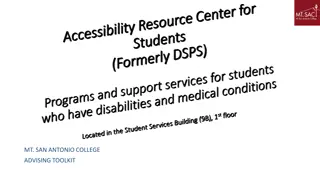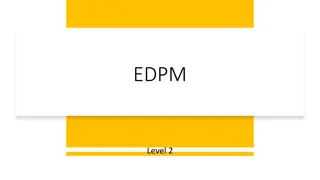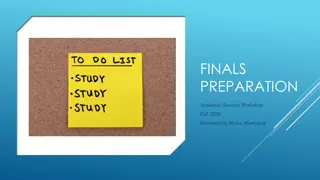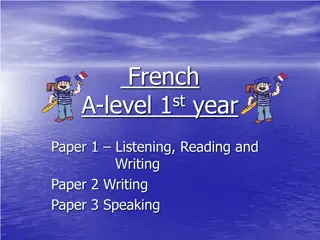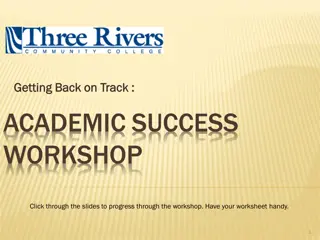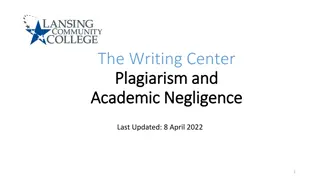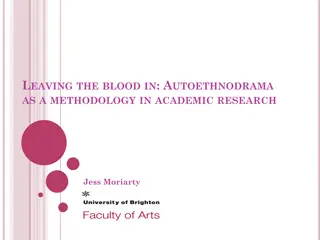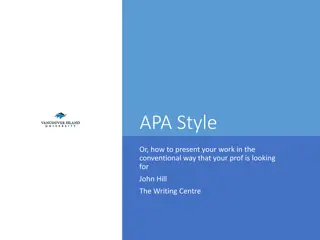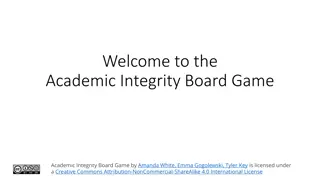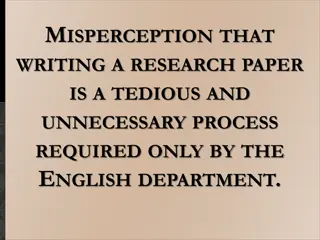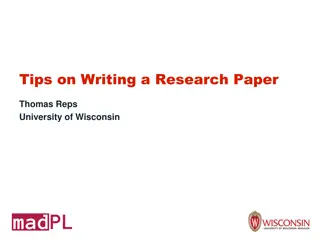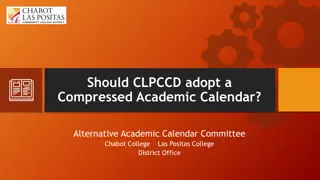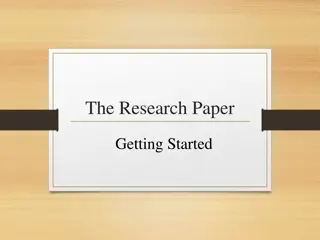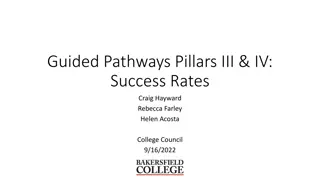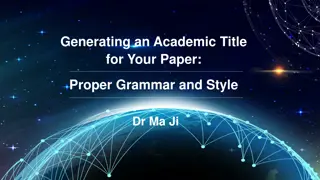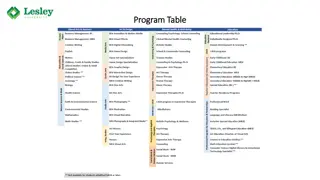Proper Organization of a Research Paper for Academic Success
Learn the essential components and structure of a research paper such as the IMRAD format, manuscript length, and manuscript organization steps. Understand the significance of each section - Introduction, Methods, Results, Discussion, and Conclusion - in presenting research effectively.
Download Presentation

Please find below an Image/Link to download the presentation.
The content on the website is provided AS IS for your information and personal use only. It may not be sold, licensed, or shared on other websites without obtaining consent from the author.If you encounter any issues during the download, it is possible that the publisher has removed the file from their server.
You are allowed to download the files provided on this website for personal or commercial use, subject to the condition that they are used lawfully. All files are the property of their respective owners.
The content on the website is provided AS IS for your information and personal use only. It may not be sold, licensed, or shared on other websites without obtaining consent from the author.
E N D
Presentation Transcript
The IMRAD format (research papers) Conclusion Discussion Results Methods Introduction Acknowledgements What does it mean? What did you How did you do What did find? it? you/others do? Why did you do References it? Supporting Materials
Achtung Length of the manuscript Attention Title: short and informative Abstract: 1 paragraph (<250 words) Introduction: 1,5-2 pages Methods: 2-3 pages Results: 6-8 pages Discussion: 4-6 pages Conclusion: 1 paragraph Figures: 6-8 ( one per page) Tables: 1-3 (one per page) References: 30 -50 publications (2-4 pages)
Preparing a research paper TITLE INTRODUCTION ABSTRACT 30-40 characters A brief summary of the sections Nature and scope of the problem Principle objectives Colons or commas Literature review Short Scope of the investigation Methods of investigation Methods employed, Principle results and conclusions suggested by the results Informative results and principle conclusions Principles, relations, and generalizations shown by the Overall description of the Experimental design experiment findings Enough detail to repeat the experiment Exceptions or lack of correlation Representative data Technical specifications and quantities and sourse or method of Shows how the results and interpretations agree with previous work New knowledge that the author is contributing to the world preparation Basis for repetition of the Theoretical implications of the experiment work METHODS MATERIALS RESULTS DISCUSSION
Steps to organizing your manuscript Tables give the actual experimental results, while figures are often used for comparisons of experimental results with those of previous works, or with calculated/theoretical values. If your paper is proposing a new method, you need to include detailed information so a knowledgeable reader can reproduce the experiment. But do not repeat the details of the established methods. Only representative results from your research should be presented. The results should be essential for the discussion.
Steps to organizing your manuscript Make the Discussion corresponding to the Results, but do not reiterate the results. You need to compare the published results by your colleagues with yours. Never ignore work in disagreement with yours, in turn, you must confront it to convince the reader that you are correct or better. This section shows how the work advances the field from the present state of knowledge. Provide a clear justification for your work. Suggest future experiments and point out those that are underway. A good introduction should answer the following questions: What is the problem to be solved? Are there any solutions? Which is the best? What is its main limitation? What do you hope to achieve?
Steps to organizing your manuscript 7. WRITE THE ABSTRACT What was done? What were the main findings? 8. COMPOSE A CONCISE AND DESCRIPTIVE TITLE Needs to be specific Reflects the content of the manuscript 9. SELECT KEYWORDS FOR INDEXING Avoid words with broad meaning Include the words that are already included in the title and the abstract 10. REFERENCES Do not include unpublished observations, manuscripts submitted but not yet accepted for publication, publications that are not peer reviewed, grey literature, or articles not published in English
SUCCESSFUL SCHOLARLY PUBLICATION: PARAMETERS LINGUISTIC, SYNTACTICAL, LEXICAL AND STYLISTIC DEVICES LOGICAL STRUCTURE OF RESEARCH CORE IDEA, MAIN THETHIS
TIPS Title Papers with titles between 31 and 40 characters are cited the most. Titles containing a comma or colon are cited more. Avoid question marks and exclamation marks. The title should convey the most interesting and surprising new results from the study. Broadly explains what the paper is about.
Abstract TIPS Use active voice when possible. Write concise, but complete, sentences. Use past tense because you are reporting on research that has been completed. Maximum length should be 200-300 words, usually in a single paragraph. Avoid non-standard or uncommon abbreviations. Summarizes the major aspects of the entire paper in the following sequence: the question(s) investigated (or purpose) (from Introduction), the experimental design and methods used (from Methods), the major findings including key quantitative results, or trends (from Results), a brief summary of your interpretations and conclusions (from Discussion).
TIPS Author(s) The person who writes the manuscript is usually the first author . The second most important position is the last person of the list. In between those two critical positions, you will find everyone else in order of importance. So the second position is the third best, the third is the fourth best, etc. Indicates the given name(s) and family name(s) of each author.
TIPS Affiliation An affiliation is an institution that pays the authors for their work. Authors can have multiple affiliations. Be aware that each affiliation is attributed a share of the author s scores. This means that an author with affiliations in several countries will not count fully in each. Presents the authors' affiliation addresses (where the actual work was done). Provides the full postal address of each affiliation, including the country name and, if available, the e-mail address of each author.
TIPS Keywords Avoid words with a broad meaning and words already included in the title. (Check the journal requirements)
TIPS Highlights Include 3 to 5 highlights. There should be a maximum of 85 characters, including spaces, per highlight. Only the core results of the paper should be covered. Provide a short collection of bullet points that convey the core findings and provide readers with a quick textual overview of the article.
TIPS Introduction Use personal pronouns (I/we) to announce the research and principle findings. Organize the introduction from general background to specific, relating to your research. Do not mix the introduction with results, discussion, and conclusion. Presents the nature and scope of the problem investigated. Briefly reviews the pertinent literature to orient the reader. States the methods of the investigation. If necessary, the reasons for the choice of a particular method (the rationale of the research) States the principle results of the investigation. States the principle conclusions suggested by the results.
TIPS Materials & Methods Use personal pronouns (I/we) to explain a procedure and to assume your personal responsibility for actions or decisions that were different from the norm or from what was expected. Use past tense to describe the details of your research. Do not repeat the details of the established methods. List the methods in the logical order in which you conducted the research. Avoid adding comments. Describes (if necessary, defends) the experimental design. Provides enough detail so that a competent worker can repeat the experiment. Provides information that will let readers judge the appropriateness of the experimental methods. Includes the exact technical specifications and quantities and sources or methods of preparation.
TIPS Results Use personal pronouns (I/we) to express your responsibility for particular methodological decisions. Use past tense when referring to your results. Use tables to present the actual experimental results. Use figures for comparisons of experimental results with those of previous works, or with calculated/theoretical values. Do not include references. Gives some kind of overall description of the experiment, providing the big picture. Provides representative data. Constitutes the new knowledge that the author is contributing to the world.
TIPS Discussion Use personal pronouns (I/we) to claim responsibility for findings that may carry novelty to the scientific community. Use of the first person is generally acceptable, but too much use of the first person can actually distract the reader from the main points. Never ignore work in disagreement with yours. Presents the principles, relations, and generalizations shown by your research findings. Points out any exceptions or any lack of correlation. Shows how your results and interpretations agree (or contrast) with previously published works. Provides theoretical implications of your research, as well as any possible practical applications.
TIPS Conclusion Highlights key points in your analysis or results. Notes important or unexpected implications applied to practice. Summarizes your thoughts and conveys the significance of your study and the importance of your ideas. Identifies how a gap in the literature has been addressed. Introduces possible new or expanded ways of thinking about the research problem. Offers new insights and creative approaches for the research problem based on the results of your study. Use Present Simple to write about what is now known or is still needed. Do not introduce new information. Do not repeat the abstract. Do not list experimental results.
TIPS Acknowlegements Avoid the word "wish". Before mentioning someone in an acknowledgement, obtain permission from him or her. Acknowledges any significant technical help received from any individual, as well as any outside financial assistance, such as grants or fellowships.
References TIPS Before using citation management software (EndNote, RefWorks, Mendeley, etc.), check the journal's requirements. Cite papers from the journal to which the paper will be submitted. Include most recent papers from the domain. Cite papers that other researchers in your domain see as important and cite often themselves. Never cite what you have not read. Lists significant published works. Cites all the scientific publications on which your work is based.
Written Communication Performance Correctness of punctuation and spelling o Overall writing ability o Quality of content o Quality of overall paper organization o Quality of paragraph organization o Correctness of vocabulary usage o Vocabulary size o Quality of sentence structure o Correctness of punctuation Quality of sentence structure
The commandments Be as clear, concise, and focused as possible without sacrificing the meaning of your writing. 1 Keep your sentences as well as paragraphs reasonably short less is more! 2 3 Simplify, otherwise you will lose your readers. 4 Choose from among the many variables and stick to your choice. Think small decide what specifically you want to write about and make sure you stick to the subject, cover it well and ... stop. 5
The commandments 6 Write in active voice. Use I and We for self-promotion in the international academic community. 7 Frame and contextualize everything and always let your reader know what you are doing and why. 8 9 Define all your terms the moment you first mention them. 10 Avoid unnecessary jargon.
The commandments The use of performance measurements is designed to provide all levels of management and eventually the Board with a device that will afford the criteria to make some determination as to the cost-benefit ratio effectiveness of any given activity and consequently a determination of the funding level. 47 words
The commandments The designed to provide all levels of management and eventually the Board with a device that will afford the criteria to make some determination as to the cost-benefit ratio effectiveness of any given activity and consequently a determination of the funding level. use of performance measurements is
The commandments The performance measurements is designed to will provide all levels of management and eventually the Board with a device that will afford the criteria to make some determination as to the cost-benefit ratio effectiveness of any given activity and consequently a determination of the funding level.
The commandments The performance measurements will provide give all levels of management and eventually the Board with a device that will afford the criteria to make some determination as to the cost-benefit ratio effectiveness of any consequently a determination of the funding level. given activity and
The commandments The performance measurements will give all levels of management and eventually the Board a device that will afford the criteria to make some determination as to effectiveness of any consequently a determination of the funding level. the given cost-benefit activity ratio and
The commandments The performance measurements will give all levels of management a device tool that will afford the criteria to make some determination as to the cost-benefit ratio effectiveness of any given activity and consequently a determination of the funding level.
The commandments The performance measurements will give all levels of management a criteria-setting tool that will afford the criteria to make some determination as to the cost-benefit ratio effectiveness of any given activity and consequently a determination of the funding level.
The commandments The performance measurements will give all levels of management a criteria-setting determining as to the effectiveness of any consequently a determination of the funding level of every activity. tool for cost-benefit activity ratio and given
The commandments The performance measurements will give all levels of management a criteria-setting determining the cost-benefit ratio and consequent funding level of every activity. 25 words tool for
Common issues: pronouns he, she, him, her, it, they, this, that, these, those, which, that Henry Jones told John Smith that the paper on which he was working needed more citations.
Common issues: pronouns Whose paper needed more citations Henry s or John s? Henry Jones told John Smith that the paper on which he, Jones, was working needed more citations. Henry Jones told John Smith that the paper on which Henry was working needed more citations. HenryJones told John Smith that the paper on which Smith was working needed more citations. HenryJones told John Smith that the paper on which John was working needed more citations.
Common issues: pronouns this, that, these, those In contrast to this, the group of low-income parents do not have the means to save in order to insure themselves against future risks. In contrast to this, the group of low-income parents do not have the means to save in order of saving to insure themselves against future risks. What risks? [financial? medical?]
Common issues: pronouns it, they Related studies put forward three possible explanations for this phenomenon. They start from two common premises. Related studies put forward three possible explanations for this phenomenon. These studies start from two common premises. Related studies put forward three possible explanations for this phenomenon. These explanations premises. start from two common
Common issues: pronouns I, we Nowhere has anyone attempted ... In this article I aim to do just that A corpus-based study of self-promotional I and we in academic writing across four disciplines Nigel Harwood The Department of Language and Linguistics, University of Essex, Wivenhoe Park, Colchester C04 3SQ, UK Journal of Pragmatics, 2005
Common issues: squinting modifiers The researchers said on Wednesday they would attend the meeting. On Wednesday the researchers said that they would attend the meeting. The researchers said that they would attend the meeting on Wednesday. The researchers said that they would attend the Wednesday meeting.
Common issues: misplaced modifiers Professor Smith has resigned as head of research after having worked here for 10 years to the regret of the entire staff. To the regret of the entire staff, Professor Smith has resigned as head of research after having worked here for 10 years. Professor Smith, to the regret of the entire staff, has resigned as head of research after having worked here for 10 years. Professor Smith has resigned head of research, to the regret of the entire staff, after having worked here for 10 years. The entire staff regrets the resignation of Professor Smith as head of the research, after his 10-year career here at the institute.
Common issues: dangling modifiers Based on our review of the findings, we agree that the researcher should reconsider his conclusions. Based on our review of findings, our decision is that the researcher should reconsider his conclusions. Based on our review of findings, our position is that the researcher should reconsider his conclusions. After reviewing the findings, we agree that the researcher should reconsider his conclusions.
Aristotles Logic Pathos (Emotional) -persuading by appealing to the reader s emotions. Language choice affects the audience s emotional response, and emotional appeal can effectively be used to enhance an argument Ethos (Credibility) -convincing by the character of the author. The necessity to project an impression to the reader that you are likable and worthy of respect Ethos Pathos Logos . Logos (Logical) - persuading by use of solid evidence and reasoning
Thank you for your attention !



